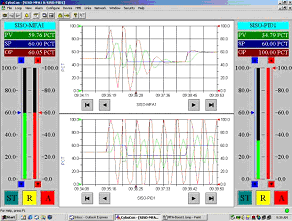MFA vs PID Control Comparison
PID Control
Most industrial processes are still being controlled
manually or by 60-year-old PID controllers. PID is a
simple general-purpose automatic controller that is
useful for controlling simple processes. However, PID
has significant limitations:
1. PID works for the process that is basically linear
and time-invariant and cannot effectively control complex
processes that are nonlinear, time-variant, coupled,
and have large time delays, major disturbances, and
uncertainties. Industrial processes with changing fuels
and operating conditions are complex processes for which
PID control is insufficient.
2. PID parameters have to be tuned properly. If the
process dynamics vary due to fuel changes or load changes,
PID needs to be re-tuned. Tuning PID is often a frustrating
and time-consuming experience.
3. PID is a fixed controller, which cannot be used as
the core for a smart control system.
PID Self-Tuning Methods
To deal with the PID tuning problems, PID auto-tuning
and self-tuning have been developed. These special PIDs
work well in some cases, but they also have some fundamental
problems.
If the self-tuning is model-based, finding and keeping
a good process model for re-tuning the PID is a major
challenge. Insertion of a test signal into the process
is often required. Since this will cause a bump to the
process, operators find model-based PID self-tuning
awkward to use.
If the self-tuning is rule-based, it is difficult to
distinguish between the effects of load disturbances
and genuine changes in the process dynamics. The controller
may thus overreact to a disturbance and create an unnecessary
adaptation transition. Also, the reliability of the
tuning may be questionable since there are no mature
stability criteria available for rule-based systems.
Most importantly, if the PID controller is unable to
deal with the complex process, no matter how it is tuned,
the system will not work. For this reason, self-tuning
or auto-tuning PIDs are not good candidates for a smart
control system.
Comparison of MFA and PID
The adaptive capability of MFA is illustrated when comparing
with a PID. The performance of MFA (top) and PID (bottom)
is compared to show how MFA adapts when process dynamics
change.
Starting from the same oscillating control
condition, the system will continue to oscillate
under PID control, while the MFA system will
quickly adapt to an excellent control condition.
When the setpoint is changed again, MFA does
not oscillate anymore.
If both controllers start from a sluggish
situation, MFA will control the process faster
and better while PID will remain sluggish.
|
|
 |
|